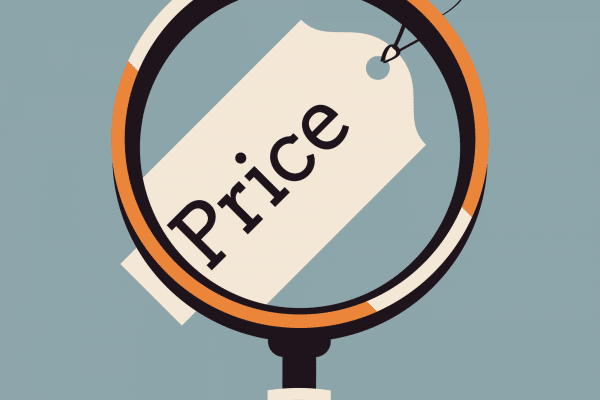The strategic significance of price shows how product, distribution, price, and promotion strategies must all work together to form an integrated marketing plan and product positioning.
One needs to analyze the pricing situation before developing a pricing strategy. This involves deciding on a product mix or product line, as well as deciding on a pricing strategy for a new product or brand.
You grade the prices according to how the company’s price compares to the competition. How active the price incentive will be in the marketing campaign. Read on to discover the different pricing analysis techniques like competitive pricing, cost pricing, and conjoint pricing.
What is Pricing Analysis?
Price Analysis in marketing refers to the examination of customer responses to hypothetical prices in survey research.
Price analysis, in the general industry, is the method of analyzing and assessing a proposed price without evaluating its separate cost elements and proposed profit. It dates back to 1939 when an Economist named Andrew Court decided to devote his attention to Price Analysis to better understand the environmental factors that affect this activity.
What is the difference between Competitive Pricing and Pricing Analysis?
Competitive pricing analysis is a pricing policy that uses the prices of rivals as a benchmark for setting prices. This technique is also known as competition-based or competitor-based pricing. In most cases, businesses adopt a dynamic pricing strategy after determining that a cost-plus solution is no longer viable.
Competitive pricing analysis is an assessment of consumers’ reactions to new prices through studies based on historical data or polling. Typically, price analysis measures consumers’ reactions to a price without taking into account the costs and future income for the company.
What Is the Importance of a Competitive Pricing Strategy in Pricing Analysis?
According to Forrester Consulting, 81% of shoppers match deals from several stores in search of a better deal. Retailers who can collect and analyze market data, chart their position against rivals, and deliver competitive pricing are the first to capture these buyers’ attention.
Competitive pricing is a pricing technique that assists companies in attracting more consumers by maximizing prices based on competitor goods and pricing data. An effective pricing analysis technique will dramatically increase sales, improve supplier cooperation, and increase revenue.
Conjoint Pricing Analysis
Conjoint pricing analysis is a methodology from the 1970s to define the secret laws that consumers use to make buying decisions. Every customer must choose between price and quality. The conjoint pricing analysis measures the various features of a product in different combinations to determine how much emphasis consumers put on each variation of the product.
Conjoint Pricing Analysis Example
Conjoint pricing analysis can become complicated depending on the number of product attributes tested and the number of price scenarios.
As an example,
Collect brand information and the characteristics you want to assess based on the pricing structures you create, such as Brand A at $1.25, Brand A at $1.50, Brand A at $2.25, and so on. If you are comparing competing brands, you should also determine alternate prices for the competitors’ brands. Choose a tool for interacting with respondents, such as in-person interviews, computer-based research, or focus groups. To measure the responses, assign a ranking to each one. Gather the responses and tabulate the findings after you the analysis is completed.
furthermore, several software programs exist that allow you to create market models based on the findings of the conjoint pricing analysis technique.
Constraints of Conjoint Pricing Analysis
Conjoint pricing analysis enables you to test various pricing techniques for different product attributes that are appealing to your consumer base. In certain situations, a respondent’s answers may not accurately reflect his purchasing motivation. Price may be only one factor influencing his buying decision.
Another consideration is that respondents can choose the lowest price under the mistaken assumption that they have given the “right” response. On the other end of the continuum, a respondent could choose the most expensive item being tested, regardless of how outrageously priced, due to brand loyalty.
Insight
Using conjoint analysis as part of your pricing study is only one of the many resources available to you under the umbrella of marketing research. No single approach proves to be a more accurate predictor of consumer psychology. To arrive at an optimum pricing strategy for your brand, it is best to use a combination of testing methods in conjunction with conjoint analysis. Conjoint analysis can be too costly and time-consuming for a small company. In certain situations, adjusting your product price and tracking your sales, along with follow-up calls to your clients, will provide you with the details you need to develop a solid pricing plan.
How to do a Price Analysis?
You don’t need to be concerned; it’s not rocket science. In reality, it’s a required, highly beneficial, but not particularly painful process that we’ll walk you through.
To begin, you must understand your position in the competitive landscape. Consider the following example.
Consumers who shop online know where to look for the best deals. Don’t you do this when you shop online? You’re more likely to prefer the store at the end.
That is why most of your rivals will want to deliver the best value, and you must understand where your rates stand in comparison to theirs.
But first and foremost, describe the rivalry. Who else sells the same things you do, and who provides alternatives to yours? The first is your direct competition, and the second is your indirect competition.
Determine the Price Index
Find the overall selling price of a commodity after you’ve established your rivals. Then, for each of your items, compute the price index.
Here’s a simple calculation formula you can use to measure it for a single product to give you an idea.
What are the benefits of Price Index analysis?
Assume a rival has lower prices than you for a specific brand, but it is more costly for all of the other brands you compare. She most likely negotiated a better deal with the supplier.
Another explanation is that she has lower operating costs, but this will most likely be reflected in the prices of the other labels.
You will have more bargaining power with the supplier now that you have this knowledge.
And if you don’t get a better offer, you can concentrate on your weak point and put more effort into promoting the brand.
Alternatively, you may decide to shift your focus away from that brand and toward one in which you have a competitive advantage. In this case, you’ll be able to make an educated decision.
In another case, if you find out that you’re charging a lower-than-average price for a commodity. You can raise your prices to the point that you still deliver the best price while still increasing your profit margins.
Utilizing historical price information.
We understand that keeping track of competitor pricing is both time-consuming and expensive. However, it contains incredibly useful information.
After collecting the data for a while, you’ll find trends and patterns in competitor action. You’ll learn about their off-season discount schedule, the items they discount the most, how much their rates rise after Cyber Monday, and so on. When you have this knowledge, you will be able to react to their pricing strategies without losing money.
In addition, you must examine your historical price details. Which price points drew the most buyers, which goods are more elastic than others, and how has your competitive strength changed since the beginning of the year? Did you gain competitive power, and is it solely due to your lower-than-average prices? Many insights can be extracted from historical price data, but accessing big data is difficult.
Price Analysis Techniques
Any procurement of products or services, including sole source objects, necessitates some kind of cost price analysis. Pricing verification is a component of this research. There are several methods for analyzing a product’s or service’s pricing. The Federal Acquisition Regulation contains cost price analysis techniques. Among the price analysis techniques suggested are:
#1. Competitive Bids Comparison
Obviously, this is one of the most effective methods for price validation. We may decide whether a price is fair by asking three or more suppliers for their prices on the same product. This does not, however, exclude total cost analysis. The lowest bid does not always equal the lowest cost. You must calculate the overall acquisition cost.
There may be additional costs associated with making the lower-cost product perform to expectations, such as the cost of early replacement or the cost of redesign and/or testing needed to make the lower-cost product applicable. This absolute cost of acquisition reflects the actual cost you need to compare. There will be a need for a brief explanation of why you chose a specific quotation.
#2. Prior Quotations Comparison
In certain cases, comparing recent (within the last 24 months) quotations for the same product or service can be the most successful way to ascertain the viability of the current quotation. This is especially useful when the acquisition’s timing is crucial and soliciting favorable quotes will cause the purchase to be delayed. A description of why you compare the prior quote must accompany this practice.
#3. Comparison of Publicly Available Price Lists
One can use this approach only for materials that are sufficiently close to products or services that are accessible to the general public and whose prices are in a price list. When comparing these price lists, it is important to remember to take into account normal industry discounts for the goods or services.
For example, most electrical supply houses will provide standard discounts to customers who spend a certain amount of money or buy a certain quantity of products. When comparing list rates, certain discounts must be taken into account and recorded in the procurement documents.
#4. Prices are fixed by law or regulation.
Prices are often set by statute or regulation. When this happens, there is normally some kind of “pronouncement” that refers to the pricing structure. When purchasing certain items, this must be referred to.
#5. Comparison of Comparable Products
When an object or service is fairly new, similar objects to those being purchased may be compared. Also, the price comparison should be accompanied by an explanation of why the common item would not reach the specification.
#6. Comparisons Using Rough Yardsticks
This price analysis technique compares related products based on observable similarities such as price per pound, cost per horsepower, or price per test sample. This research must, once again, be accompanied by an interpretation of the similarities.
It is often difficult to find equivalent goods or facilities. In such cases, it may be appropriate to rely on technical research. Though time-consuming, this is the best method for validating prices for complex sole source objects. The supplier of products or services is asked to include the following information in this analysis:
- Materials and their costs are mentioned.
- The number and type of labor hours needed.
- Any potential special tooling or services.
- A feasible strategy for the use and recycling of scrap.
- Any other expense related to the cost of delivering the service or good, including benefit.
The above-mentioned techniques are then applied to each object on the supplier’s bill of materials. Variables such as overhead and benefits can also be negotiated. The exercise must be registered once more.
Read Also: WHAT IS DYNAMIC PRICING? How It Works with Examples
Complete a Comprehensive Pricing Analysis
- Outline your pricing strategy at a high level.
- Align Price with Profitability Goals
- Examine the prices of your competitors and also choose your own price.
- Examine Price Changes Among Competitors
- Determine a single customer’s profitability
- Consider the Consequences of Raising or Lowering Your Price.
How can businesses determine the right price for their products or services?
Businesses can determine the right price for their products or services by conducting pricing analysis and considering factors such as costs, competition, market demand, and customer preferences.
How can businesses adjust prices to remain competitive?
Businesses can adjust prices to remain competitive by regularly conducting pricing analysis and monitoring changes in the market, competition, and customer preferences.
What are the risks of setting prices too high?
The risks of setting prices too high include decreased sales and reduced customer loyalty.
What are the risks of setting prices too low?
The risks of setting prices too low include decreased profits and reduced brand value.
How can businesses use pricing analysis to increase profits?
Businesses can use pricing analysis to increase profits by determining the optimal price that will maximize profits and remain competitive in the market.
How can technology, such as data analysis tools, impact pricing analysis?
Technology, such as data analysis tools, can impact pricing analysis by providing access to real-time data and insights on market trends, customer preferences, and competitor pricing.
Conclusion
Time is needed in both price and cost analysis. Even if support is not yet guaranteed, we suggest starting the process as soon as possible. In both cases, the Procurement team would be able to assist.
As an online retailer, you must be well aware that customers want the lowest possible price. As a result, you must compete on price. Before settling on a pricing plan, you must perform a price analysis to determine your competitive position.
As a first move, identify your competitors. The Price Index is then calculated to expose competitor strategy in the short term. Furthermore, you should constantly change your prices in relation to rivals in order to maintain/improve your competitive strength.
However, in order to achieve long-term success, you must study historical price data to determine what rivals plan to do in the long run and how they will act in the long run. The pricing tools will help you with these processes and access big data that would otherwise be difficult to obtain.
Pricing Analysis FAQs
What are the 5 pricing strategies?
Pricing strategies to attract customers to your business
- Price skimming. …
- Market penetration pricing. …
- Premium pricing. …
- Economy pricing. …
- Bundle pricing. …
- Value-based pricing. …
- Dynamic pricing.
How do you do price analysis?
You need to figure out the price at which you can maximize your profit.
- Document your cost structure.
- Capture your main competitors’ prices.
- Estimate how sensitive your market is to price fluctuations.
- Calculate the price and volume that will maximize profit.
- Recommend a price.
What do pricing analyst do?
Pricing analysts conduct research to learn the history of the product and previous market trends. Once they have set a price, they communicate with company stakeholders and track the sales of the product or service over time, making changes to the price as necessary to maximize profit.
Is a pricing analyst an actuary?
You can think of pricing actuaries as being in the “front office” of the business whereas reserving/capital (collectively commonly called “actuarial” which can be confusing as pricing actuaries are actuaries too!) are middle office functions.
{
“@context”: “https://schema.org”,
“@type”: “FAQPage”,
“mainEntity”: [
{
“@type”: “Question”,
“name”: “What are the 5 pricing strategies?”,
“acceptedAnswer”: {
“@type”: “Answer”,
“text”: “
Pricing strategies to attract customers to your business
- Price skimming. …
- Market penetration pricing. …
- Premium pricing. …
- Economy pricing. …
- Bundle pricing. …
- Value-based pricing. …
- Dynamic pricing.
“
}
}
, {
“@type”: “Question”,
“name”: “How do you do price analysis?”,
“acceptedAnswer”: {
“@type”: “Answer”,
“text”: “
You need to figure out the price at which you can maximize your profit.
- Document your cost structure.
- Capture your main competitors’ prices.
- Estimate how sensitive your market is to price fluctuations.
- Calculate the price and volume that will maximize profit.
- Recommend a price.
“
}
}
, {
“@type”: “Question”,
“name”: “What do pricing analyst do?”,
“acceptedAnswer”: {
“@type”: “Answer”,
“text”: “
Pricing analysts conduct research to learn the history of the product and previous market trends. Once they have set a price, they communicate with company stakeholders and track the sales of the product or service over time, making changes to the price as necessary to maximize profit.
“
}
}
, {
“@type”: “Question”,
“name”: “Is a pricing analyst an actuary?”,
“acceptedAnswer”: {
“@type”: “Answer”,
“text”: “
You can think of pricing actuaries as being in the \”front office\” of the business whereas reserving/capital (collectively commonly called \”actuarial\” which can be confusing as pricing actuaries are actuaries too!) are middle office functions.
“
}
}
]
}
- Competitor Analysis: All you need (+ How to Start Guide)
- Competitive Pricing: How to do Competitor Pricing Analysis
- Sustainable Competitive Advantage: Simple Steps to Gain a Sustainable Competitive Advantage
- Pricing Strategies: Top 7 Examples of Pricing Strategies
- Per Stirpes: Definition, Comparison, Distribution, and Beneficiary Methods.






